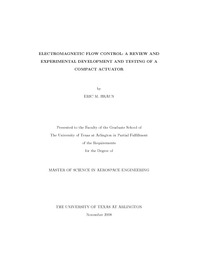| dc.description.abstract | This thesis is divided into two sections which both relate to the field of magnetohydrodynamics and particularly electromagnetic flow control (EMFC). The first section contains a review of recent research in EMFC. The second section presents the experimental results of a compact EMFC actuator designed for use at low speeds where the flow conductivity is raised by conductive seed particle injection.Fifty years ago, publications began to discuss the possibilities of using EMFC to improve aerodynamic performance. This led to an era of research that focused on coupling the fundamentals of magnetohydrodynamics (MHD) with propulsion, control, and power generation systems. Unfortunately, very few designs made it past an experimental phase as, among other issues, power consumption was unreasonably high. Recent proposed advancements in technology like the MARIAH hypersonic wind tunnel and the AJAX scramjet engine have led to a new phase of MHD research in the aerospace industry, with many interdisciplinary applications. Aside from propulsion systems and channel flow accelerators, electromagnetic flow control concepts applied to control surface aerodynamics have not seen the same level of advancement that may eventually produce a device that can be integrated with an aircraft or missile. Therefore, the purpose of this thesis is to review the overall feasibility of the different electric and electromagnetic flow control concepts. Emphasis is placed on EMFC and experimental work.The second section describes the development and testing of a facility for electromagnetic boundary layer flow control employing conductive particle seeding. It was designed and constructed to perform basic research in EMFC and address some of the issues discussed in the review. The facility consists of three integrated components: a conductive particle seeding system, an ionization actuator, and a Lorentz force actuator. The Lorentz force actuator was designed in particular to be compact, employing a row of flush-mounted surface electrodes alternated with embedded NdFeB magnets perpendicular to the flow direction. Experiments were performed in a low-speed wind tunnel with atmospheric pressure. Low ionization energy potassium carbonate particles were meant to be seeded into the airflow to then be ionized by a high voltage field before passing over the active EMFC actuator. Although a high voltage field can ionize air and create a glow discharge, the potassium carbonate seed is largely unaffected. It appears that the potassium carbonate seed must be broken down thermally or with a high voltage, high current pulse that contains energy at the level needed to vaporize the potassium carbonate molecules. Different forms of seeding were attempted but were largely unsuccessful. A glow discharge was established over the EMFC actuator, but PIV imaging indicates that the boundary layer effects produced in this case were largely a result of Joule heating and not the Lorentz force. In the conclusion, several recommendations are laid forth pertaining to the future of EMFC experimentation with compact actuators and conductive particle seeding. | en_US |

